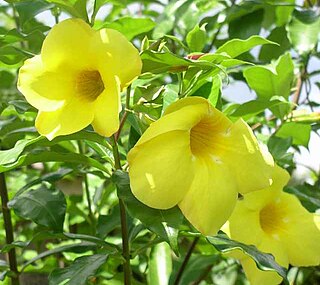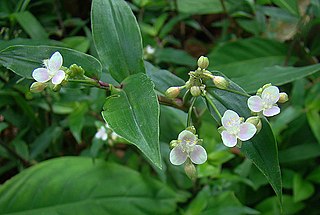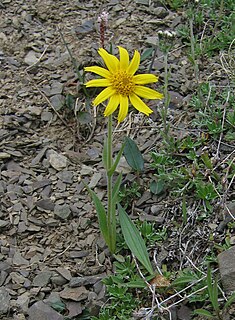
Allamanda is a genus of flowering plants in the family Apocynaceae. They are native to the Americas, where they are distributed from Mexico to Argentina. Some species are familiar as ornamental plants cultivated for their large, colorful flowers. Most species produce yellow flowers; A. blanchetii bears pink. The genus name Allamanda honors the Swiss botanist and physician Frédéric-Louis Allamand (1736–1809). It also is official flower of Kuching North City Hall.

Elaeagnus angustifolia, commonly called Russian olive, silver berry, oleaster, or wild olive, is a species of Elaeagnus, native to western and central Asia, Iran, from southern Russia and Kazakhstan to Turkey, and parts of Pakistan. As of 2020, it is widely established in North America as an introduced species.

Allamanda cathartica, commonly called golden trumpet, common trumpetvine, and yellow allamanda, is a species of flowering plant of the genus Allamanda in the family Apocynaceae. It is native to Brazil. This plant is cited in Flora Brasiliensis by Carl Friedrich Philipp von Martius.

Araucaria angustifolia, the Paraná pine, Brazilian pine or candelabra tree, is a critically endangered species in the conifer genus Araucaria. Although the common names in various languages refer to the species as a "pine", it does not belong in the genus Pinus.

Gymnanthes is a genus of flowering plants in the spurge family, Euphorbiaceae first described as a genus in 1788. It is found primarily in the warmer parts of the Western Hemisphere, but with some species in central Africa and southwestern Southeast Asia.

Verbena brasiliensis, the Brazilian verbena or Brazilian vervain, is a flowering plant species from the vervain family (Verbenaceae). It is native to parts of South America, namely Brazil, but has spread its range in recent times and has occasionally become an invasive weed. It is an annual plant with purple flowers, and it has been introduced outside of its native range as an ornamental plant, and is now largely considered an invasive weed in these regions.
Ruellia vindex is a plant native to Brazil, Guyana and Venezuela. This plant is cited in Flora Brasiliensis by Carl Friedrich Philipp von Martius.

Hakea salicifolia commonly known as the willow-leaved hakea, is species of flowering plant that is endemic to eastern Australia. It is an adaptable, fast growing small tree or shrub with attractive foliage and cream white flowers.

Allamanda blanchetii is a species of perennial flowering plant in the family Apocynaceae native to Brazil. Cultivated as an ornamental plant, it grows in full sun in USDA Zones 9b through 11 including central and south Florida, southernmost Texas, and coastal California. This plant's purple, bell-shaped blooms are about 3" across. It is also called red bell.

Allamanda schottii, commonly known as bush allamanda, is a shrub of genus Allamanda in the family Apocynaceae, which is native to Brazil. Reaching 2.5 metres (8.2 ft) in height, it bears large yellow flowers for much of the year. Grown as an ornamental plant, it has become a weed in several countries.
Allamanda puberula is a species of plant in the family Apocynaceae, which is native to Brazil, typically in Caatinga, and Cerrado vegetation. This plant is cited in Flora Brasiliensis by Carl Friedrich Philipp von Martius.

Malus angustifolia, or southern crabapple, is a species of crabapple native to the eastern and south-central United States from Florida west to eastern Texas and north to New Jersey, Pennsylvania, Illinois and Missouri.

Raddia is a genus of South American plants in the grass family, most of the species found only in Brazil.
Streptochaeta is a genus of plants in the grass family. It is the only genus in the tribe Streptochaeteae of the family Poaceae.

Tristachya is a genus of African and Latin American plants in tribe Tristachyideae within the grass family.

Osmunda spectabilis, known as American royal fern, is a species of fern native to a large area of the New World, from Canada to Argentina.
A. angustifolia may refer to:

Tripogandra is a genus of flowering plants in the spiderwort family, Commelinaceae. It is native to the Western Hemisphere from central Mexico and the West Indies south to Argentina.

Arnica angustifolia is an Arctic and alpine species of plants in the sunflower family, known by the common names narrowleaf arnica and Arctic arnica. It is native to colder regions in Europe, Asia, and North America (northern and western Canada, Alaska, northern Rocky Mountains.
This page is based on this
Wikipedia article Text is available under the
CC BY-SA 4.0 license; additional terms may apply.
Images, videos and audio are available under their respective licenses.














